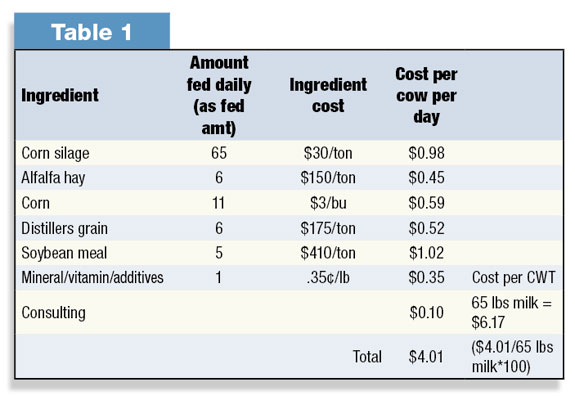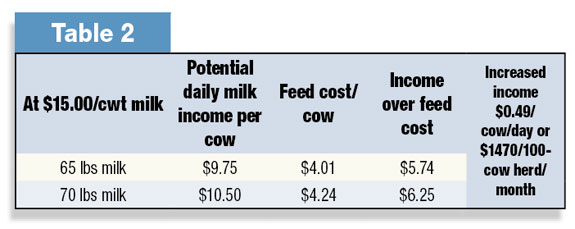Managers of dairy businesses should take time to evaluate their dairy businesses and identify areas where change is needed. Then, a game plan for accomplishing these changes needs to be designed and implemented.
In a dairy business, feed costs typically represent 40 to 50 percent of the costs of producing milk, making feed costs the largest cost category. In recent years, feed costs have represented more than 60 percent of the cost of producing milk when corn and soybean meal prices have been high. The next-highest relative costs are labor and interest at 10 to 20 percent of total cost. Thus, this begs the question – what can I do to keep feed costs down in the upcoming year?
Goals of a feeding program
Feeding programs should be designed to minimize costs while at the same time meeting the nutritional needs of dairy cows for various nutrients, such as protein, minerals, vitamins, carbohydrates and fats. Basically, we want to get cows to milk to their genetic potential this lactation and the next lactation to maximize profit for their owners. At the same time, nutritionists formulate diets that optimize the health and future reproductive performance of cows being fed.
Milking cows need certain nutrients to support a healthy immune system, which can prevent and minimize the impact of diseases, such as mastitis, and help vaccines produce the best responses to protect against disease. Rations are also formulated to protect the environment where the nitrogen (protein fraction) and phosphorus contents closely meet the cows’ needs and are not fed in excess amounts.
Sometimes feed dollars spent to achieve these goals do not result in immediate financial rewards in improved milk production. These additional nutrients may be needed to replenish body stores used during early lactation so that they are available for milk production during the next lactation.

Calculate feed cost per cowand per cwt
The first step in evaluating or reviewing the economics of a diet is to calculate current feed costs, not only on a cost-per-cow basis but also on a hundredweight of milk basis. An example is show in Table 1. With these numbers, you can compare your costs to your neighbors’ and to previous years. Also, these calculations can help you pinpoint areas you may want to change.
Should I feed the cheapest ration?
Many different combinations of forage and concentrate ingredients can be used to formulate diets that meet the goals of successful feeding programs which include getting cows to milk well. The key is to provide adequate forages and forage particle size that stimulate cows to chew their cuds and provide adequate nutrients to support realistic milk production levels for the genetics of the herd and their stage of lactation. This combination must also fit the feeding system on the farm itself.
When evaluating the costs of a diet being fed, evaluations need to be based on income over feed costs – not feed costs alone. Spending a little more in feed cost may make you more profit as long as the cows milk better, rebreed quicker or are healthier. One key point to remember is – never give up milk. As shown in Table 2 , five pounds of milk goes a long way at increasing the net income of an operation.

Ways to reduce feed costs and maximize returns over feed cost
1. Purchase ingredients in larger lots through cooperative purchases with your neighbors (that you know can cash flow the purchase).
Your neighbor does not need to be a dairy farmer – other livestock or crop enterprises also utilize feed commodities or other products that can be purchased in larger amounts for a discount.
2. Shop around for the best price.
Be careful that you are comparing prices for equivalent ingredients and that they are quality ingredients. For example, the ingredient has not been overheated to render the protein unavailable to the cow or that it contains mycotoxins (wet corn or whole cottonseed). Also, be careful to account for the moisture content of various byproducts when doing a price comparison.
3. Contract for a certain amount of an ingredient or complete feed at a set price for a set time frame from a supplier.
4. If you are purchasing ingredients as needed, evaluate their nutritive value using the Feedval spreadsheet from the University of Wisconsin.
You can then evaluate if you should discuss changing ingredients of your cows’ diet with your nutritionist.
5. Minimize shrink or feed that blows away on windy days when it is loaded into the TMR wagon or grinder mixer.

6. Feed a consistent feed mixture to your cows.
Cows are creatures of habit and their rumen bacteria perform better when they see a consistent mixture of nutrients. When feeding a TMR, the dry matter content of forages and wet byproducts needs to be measured at least weekly. Small changes (see the example in Table 3 ) can change the nutrients supplied and the health of cows. Without adjusting the amount of silages or wet byproduct for changing dry matter (or moisture content), these cows could become acidotic, go off-feed, and drop in milk production.
7. Properly mix and deliver the ration to your cows.
Cows should be fed the amounts of dry matter listed on the balanced ration. If your cows will not eat the ration supplied or forages have changed, contact your nutritionist to reformulate the diet.
8. Balance rations for your heifers and dry cows and feed them the appropriate amount of grain and composition of that grain mix.
Gone are the days when heifers are just fed four to five pounds of grain.
9. Make sure that silos stay covered and that bags of silage do not get holes from rodent or bird damage.
Air-exposed silage deteriorates quickly and cows should not be fed spoiled silage.
10. Purchase high-quality forages, i.e. alfalfa hay, based on forage analysis, not appearance.
As you assess your forage program, what can you change to improve the quality of forages that you have to feed your cows? PD
— Excerpts from Kentucky Dairy Notes, January 2010

-
Donna Amaral-Phillips
- University of Kentucky
- Email Donna Amaral-Phillips





